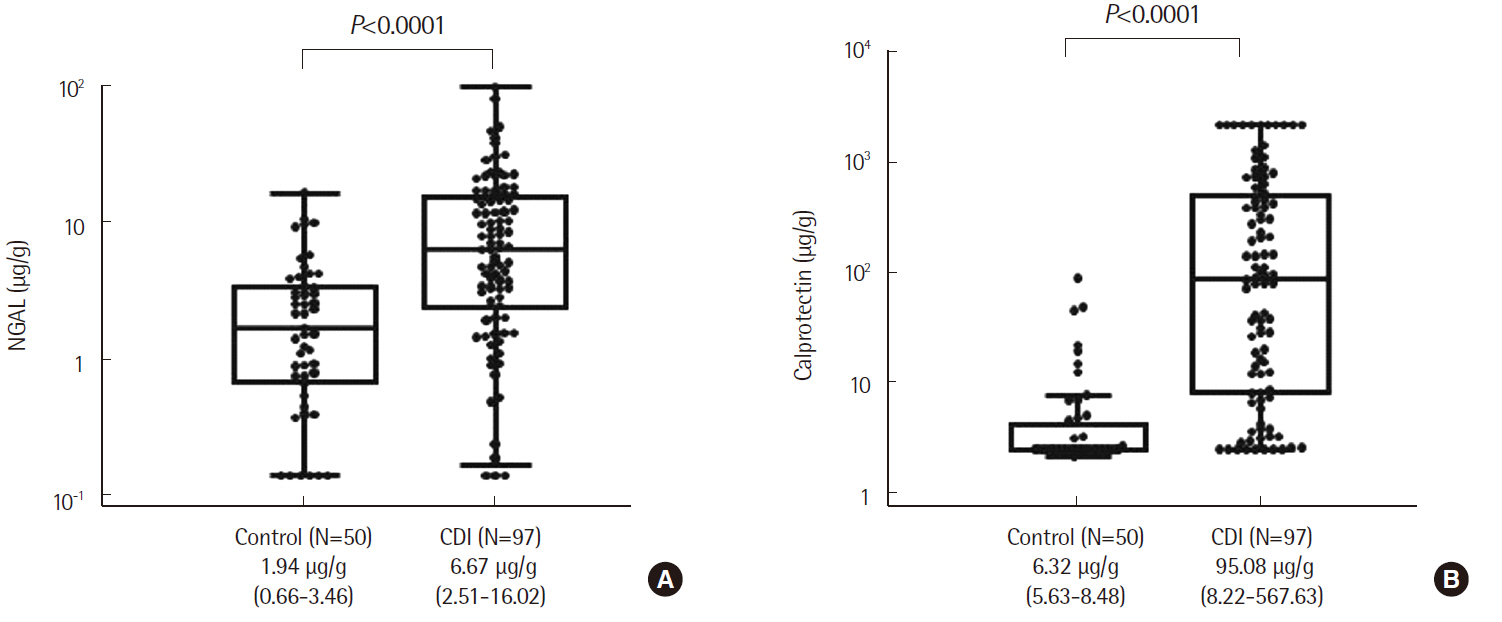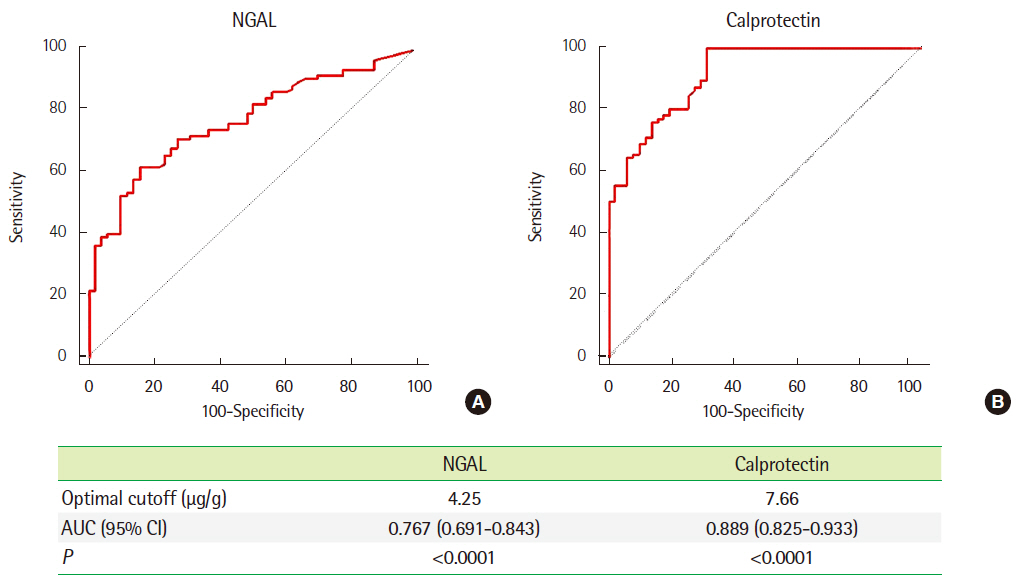Lab Med Online.
2020 Apr;10(2):125-131. 10.3343/lmo.2020.10.2.125.
Clinical Utility of Fecal Neutrophil Gelatinase-Associated Lipocalin and Calprotectin as Biomarkers of Clostridioides (Clostridium) difficile Infection
- Affiliations
-
- 1Department of Laboratory Medicine, Konkuk University School of Medicine, Seoul, Korea
- KMID: 2512242
- DOI: http://doi.org/10.3343/lmo.2020.10.2.125
Abstract
- Background
Current methods for diagnosing Clostridioides difficile infections (CDIs) fail to provide information on their severity. Fecal neutrophil gelatinase-associated lipocalin (NGAL) and calprotectin are candidate biomarkers for evaluating the severity of intestinal inflammation. We assessed fecal NGAL and calprotectin levels in patients with CDI and compared these values between subgroups of patients. We also evaluated their utility in predicting CDI clinical outcomes.
Methods
A total of 147 leftover fecal samples were obtained; 97 samples were from patients with CDI and 50 were from routine healthcare checkups. Fecal calprotectin and NGAL levels were measured using a Quantitative Fecal NGAL ELISA Kit and Quantitative Fecal Calprotectin ELISA Kit (Epitope Diagnostics, USA).
Results
Significant differences in fecal NGAL and calprotectin levels were observed between CDI patients and healthy controls (P<0.0001 for both). Significant differences in fecal NGAL and calprotectin levels were also seen between patients with high and low tcdB gene load (P=0.005 and 0.006, respectively). Fecal calprotectin levels were lower in patients with leukopenia (P=0.002), and high calprotectin levels were associated with severe CDI and treatment failure (P=0.021 and 0.033, respectively).
Conclusions
Fecal NGAL and calprotectin levels were higher in patients with CDI than in healthy controls and correlated with high tcdB gene loads. Leukopenia patients with CDI had significantly lower levels of calprotectin and the assessment should be regarded with caution. High fecal calprotectin levels were also associated with severe CDI and treatment failure. This warrants future studies with more patients and in-depth analyses.
Figure
Reference
-
1. Lawson PA, Citron DM, Tyrrell KL, Finegold SM. 2016; Reclassification of Clostridium difficile as Clostridioides difficile (Hall and O'Toole 1935) Prévot 1938. Anaerobe. 40:95–9. DOI: 10.1016/j.anaerobe.2016.06.008. PMID: 27370902.2. Balsells E, Shi T, Leese C, Lyell I, Burrows J, Wiuff C, et al. 2019; Global burden of Clostridium difficile infections: a systematic review and meta-analysis. J Glob Health. 9:010407. DOI: 10.7189/jogh.09.010407. PMID: 30603078. PMCID: PMC6304170.
Article3. McDonald LC, Gerding DN, Johnson S, Bakken JS, Carroll KC, Coffin SE, et al. 2018; Clinical practice guidelines for Clostridium difficile infection in adults and children: 2017 Update by the Infectious Diseases Society of America (IDSA) and Society for Healthcare Epidemiology of Amer-ica (SHEA). Clin Infect Dis. 66:987–94. DOI: 10.1093/cid/ciy149. PMID: 29562266.4. Senchyna F, Gaur RL, Gombar S, Truong CY, Schroeder LF, Banaei N. 2017; Clostridium difficile PCR cycle threshold predicts free toxin. J Clin Mi-crobiol. 55:2651–60. DOI: 10.1128/JCM.00563-17. PMID: 28615471. PMCID: PMC5648702.5. Manceau H, Chicha-Cattoir V, Puy H, Peoc'h K. 2017; Fecal calprotectin in inflammatory bowel diseases: update and perspectives. Clin Chem Lab Med. 55:474–83. DOI: 10.1515/cclm-2016-0522. PMID: 27658156.
Article6. Thorsvik S, Damås JK, Granlund AV, Flo TH, Bergh K, Østvik AE, et al. 2017; Fecal neutrophil gelatinase-associated lipocalin as a biomarker for inflammatory bowel disease. J Gastroenterol Hepatol. 32:128–35. DOI: 10.1111/jgh.13598. PMID: 27640344.
Article7. Budzynska A, Gawron-Kiszka M, Nowakowska-Dulawa E, Spiewak J, Lesinska M, Kukla M, et al. 2017; Serum neutrophil gelatinase-associated lipocalin (NGAL) correlates with clinical and endoscopic activity in ulcerative colitis but fails to predict activity in Crohn's disease. J Physiol Pharmacol. 68:859–65. PMID: 29550798.8. Foster AJ, Smyth M, Lakhani A, Jung B, Brant RF, Jacobson K. 2019; Consecutive fecal calprotectin measurements for predicting relapse in pediat-ric Crohn's disease patients. World J Gastroenterol. 25:1266–77. DOI: 10.3748/wjg.v25.i10.1266. PMID: 30886509. PMCID: PMC6421242.
Article9. Barbut F, Gouot C, Lapidus N, Suzon L, Syed-Zaidi R, Lalande V, et al. 2017; Faecal lactoferrin and calprotectin in patients with Clostridium difficile infection: a case-control study. Eur J Clin Microbiol Infect Dis. 36:2423–30. DOI: 10.1007/s10096-017-3080-y. PMID: 28801865.10. Swale A, Miyajima F, Roberts P, Hall A, Little M, Beadsworth MB, et al. 2014; Calprotectin and lactoferrin faecal levels in patients with Clostridium difficile infection (CDI): A prospective cohort study. PLoS One. 9:e106118. DOI: 10.1371/journal.pone.0106118. PMID: 25170963. PMCID: PMC4149523.11. Wright EK. 2016; Calprotectin or lactoferrin: Do they help? Dig Dis. 34:98–104. DOI: 10.1159/000442935. PMID: 26982329.
Article12. Debast SB, Bauer MP, Kuijper EJ. 2014; European Society of Clinical Microbiology and Infectious Diseases: update of the treatment guidance document for Clostridium difficile infection. Clin Microbiol Infect. 20:1–26. DOI: 10.1111/1469-0691.12418. PMID: 24118601.13. Epitope Diagnostics, Inc. 2019. Quantitative fecal calprotectin ELISA kit. http://www.epitopediagnostics.com/kt849. Last updated on May 2019.14. Epitope Diagnostics, Inc. 2019. Human fecal NGAL (LCN2) ELISA kit. http://www.epitopediagnostics.com/kt853. Last updated on May 2019.15. Sipponen T and Kolho KL. 2015; Fecal calprotectin in diagnosis and clinical assessment of inflammatory bowel disease. Scand J Gastroenterol. 50:74–80. DOI: 10.3109/00365521.2014.987809. PMID: 25523558.16. Singer E, Markó L, Paragas N, Barasch J, Dragun D, Müller DN, et al. 2013; Neutrophil gelatinase-associated lipocalin: pathophysiology and clinical applications. Acta Physiol (Oxf). 207:663–72. DOI: 10.1111/apha.12054. PMID: 23375078. PMCID: PMC3979296.
Article17. Nakashige TG, Zhang B, Krebs C, Nolan EM. 2015; Human calprotectin is an iron-sequestering host-defense protein. Nat Chem Biol. 11:765–71. DOI: 10.1038/nchembio.1891. PMID: 26302479. PMCID: PMC4575267.
Article18. Zhang A, Cai Y, Wang PF, Qu JN, Luo ZC, Chen XD, et al. 2016; Diagnosis and prognosis of neutrophil gelatinase-associated lipocalin for acute kidney injury with sepsis: a systematic review and meta-analysis. Crit Care. 20:41. DOI: 10.1186/s13054-016-1212-x. PMID: 26880194. PMCID: PMC4754917.
Article19. D'Angelo F, Felley C, Frossard JL. 2017; Calprotectin in daily practice: Where do we stand in 2017? Digestion. 95:293–301. DOI: 10.1159/000476062. PMID: 28511188.20. He T, Kaplan SE, Gomez LA, Lu X, Ramanathan LV, Kamboj M, et al. 2018; Fecal calprotectin concentrations in cancer patients with Clostridium difficile infection. Eur J Clin Microbiol Infect Dis. 37:2341–6. DOI: 10.1007/s10096-018-3381-9. PMID: 30242543. PMCID: PMC6230305.21. Rao K, Santhosh K, Mogle JA, Higgins PD, Young VB. 2016; Elevated fecal calprotectin associates with adverse outcomes from Clostridium difficile infection in older adults. Infect Dis (Lond). 48:663–9. DOI: 10.1080/23744235.2016.1186832. PMID: 27206404. PMCID: PMC4951100.22. Cho SY, Nam Y, Soh YS, Park TS, Lee HJ. 2014; To the editor: Molecular epidemiology of toxigenic Clostridium difficile isolates in Korea. Epide-miol Infect. 142:1651–2. DOI: 10.1017/S0950268813003051. PMID: 24290036.23. Davies KA, Longshaw C, Davis GL, Bouza E, Barbut F, Barna Z, et al. 2014; Underdiagnosis of Clostridium difficile across Europe: the European, multicentre, prospective, biannual, point-prevalence study of Clostridium difficile infection in hospitalised patients with diarrhoea (EUCLID). Lancet Infect Dis. 14:1208–19. DOI: 10.1016/S1473-3099(14)70991-0.24. Valiente E, Cairns MD, Wren BW. 2014; The Clostridium difficile PCR ribotype 027 lineage: a pathogen on the move. Clin Microbiol Infect. 20:396–404. DOI: 10.1111/1469-0691.12619. PMID: 24621128.25. Gallo A, Vallone C, Sabatelli L, Ventura G, Covino M, Cammarota G, et al. 2018; Fecal calprotectin in management of Clostridium difficile infection: a longitudinal study. Scand J Gastroenterol. 53:567–72. DOI: 10.1080/00365521.2017.1392598. PMID: 29065739.26. Popiel KY, Gheorghe R, Eastmond J, Miller MA. 2015; Usefulness of adjunctive fecal calprotectin and serum procalcitonin in individuals positive for Clostridium difficile toxin gene by PCR assay. J Clin Microbiol. 53:3667–9. DOI: 10.1128/JCM.02230-15. PMID: 26354814. PMCID: PMC4609681.27. Peretz A, Tkhawkho L, Pastukh N, Brodsky D, Halevi CN, Nitzan O. 2016; Correlation between fecal calprotectin levels, disease severity and the hypervirulent ribotype 027 strain in patients with Clostridium difficile infection. BMC Infect Dis. 16:309. DOI: 10.1186/s12879-016-1618-8. PMID: 27334992. PMCID: PMC4918013.
Article28. Cepheid, Xpert®. C. difficile. http://www.cepheid.com/us/cepheid-solutions/clinical-ivd-tests/healthcare-associated-infections/xpert-c-difficile. Last updated on May 2019.
- Full Text Links
- Actions
-
Cited
- CITED
-
- Close
- Share
- Similar articles
-
- A Case of Toxic Megacolon Caused by Clostridium difficile Infection and Treated with Fecal Microbiota Transplantation
- Fecal Calprotectin Level Reflects the Severity of Clostridium difficile Infection
- Fecal Microbiota Transplantation as a Treatment of Recurrent Clostridium difficile Infection: Where Are We Now and Where Are We Heading?
- Refractory Clostridium difficile Infection Cured With Fecal Microbiota Transplantation in Vancomycin-Resistant Enterococcus Colonized Patient
- Successful Resolution of Recurrent Clostridium difficile Infection Using Freeze-Dried, Encapsulated Fecal Microbiota: Pragmatic Cohort Study



